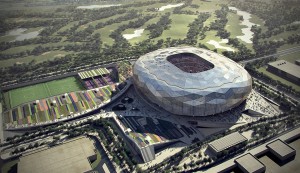
| Lusail Iconic Stadium |
| The new Lusail Iconic Stadium, with a capacity of 86,250, will host the opening and final matches of the 2022 FIFA World Cup™ if Qatar is granted hosting rights. Located in Lusail City, the stadium takes its inspiration from the sail of a traditional dhow boat and is surrounded by water. After the FIFA World Cup™, the stadium will be used to host other spectacular sporting and cultural events. |
| Doha Port Stadium |
| The new Doha Port Stadium will be a completely modular stadium with 44,950 seats. The stadium, which will sit on an artificial peninsula in the Gulf, is designed to evoke its marine setting. Water from the Gulf will run over its outer facade, aiding in the cooling process and adding to its visual allure. Fans will have the option of arriving on a water taxi or ferry. After the FIFA World Cup™, the whole stadium will be disassembled and the seats sent to developing countries to further their football development. |
| Sports City Stadium |
| Drawing inspiration from traditional Arab tents, Sports City Stadium will have 47,560 seats. A retractable roof, partly retractable pitch and retractable stands will make the stadium Qatar's premiere multi-use facility in the decades following the 2022 FIFA World Cup™. The stadiums innovative features will make it an ideal venue for football matches, but also concerts, theatre performances and non-football related athletic events. |
| Qatar Foundation Stadium > |
| The new, 40,000 seat stadium will be located in Education City, the home of Qatar Foundation for Education, Science and Community Development (QF). It will fulfil all FIFA requirements for hosting matches through to the quarter-finals of the 2022 FIFA World Cup Qatar™. It is being delivered by QF, one of the stakeholders of the Supreme Committee for Delivery & Legacy (SC). ASTAD Project Management is the project manager for Qatar Foundation Stadium. RFA Fenwick Iribarren Architects serves as the lead design consultant. |
| Umm Slal Stadium |
| Umm Slal Stadium, located in the vicinity of one of Qatar's most historically important forts, will have 45,120 seats. The design is a modern interpretation of traditional Arab forts, like the one in nearby Umm Slal Mohammed. After the FIFA World Cup™, seating capacity will be reduced to 25,500. The stadium will be used by Umm Slal F.C. |
| Qatar University Stadium |
| Replacing an existing track and field stadium on Qatar University's campus, Qatar University Stadium will have 43,520 seats. The stadiums gold facade blends traditional Arabic geometric patterns with free-form open surfaces, conjuring both past and future. The stadium will be used by student athletes following the FIFA World Cup™, with a seating capacity of 23,500. |
| Al-Gharafa Stadium |
| The existing 21,175 capacity Al-Gharafa stadium will be expanded to 44,740 seats using modular elements forming an upper tier. The facade will be made up of ribbons representing the nations that qualify for the 2022 FIFA World Cup and will symbolize football and the mutual friendship, tolerance and respect that the tournament represents. The stadium will be downscaled to its existing capacity after the tournament ends. |
| Al Bayt Stadium— Al Khor City > |
| The Aspire Zone Foundation, a stakeholder of the Supreme Committee for Delivery & Legacy (SC), will deliver Al Bayt Stadium – Al Khor City and the surrounding precinct. In 2022, the stadium will have the capacity to host 60,000 spectators, and will fulfil all FIFA requirements for hosting FIFA World Cup™ matches through to the semi-final round. Dar Al Handasah serves as the design consultant for Al Bayt Stadium – Al Khor City and the surrounding precinct, and Projacs serves as the project manager. |
| Al-Rayyan Stadium > |
| Al Rayyan Stadium and Precinct, which will be built on the site of Ahmed Bin Ali Stadium, are designed to showcase Qatar’s culture. The Supreme Committee for Delivery & Legacy (SC) will deliver the new, 40,000-seat Al Rayyan Stadium, which is a proposed venue for the 2022 FIFA World Cup Qatar™. AECOM is the stadium's project manager, while the design work is being undertaken by Ramboll and Pattern Design. |
| Al-Wakrah Stadium > |
| Located approximately 15 kilometres south of Doha, Al Wakrah is one of the oldest continuously inhabited areas in Qatar. Taking the dhow boats that carried generations of Qatari fishermen and pearl divers as inspiration, the design of Al Wakrah Stadium and the approximately 586,000m2 surrounding precinct weaves together the city’s cultural heritage with Qatar’s progressive outlook, as defined in the Qatar National Vision 2030 (QNV 2030). In addition to the stadium and precinct, Al Wakrah’s seafaring identity will be incorporated into the 2022 FIFA World Cup Qatar™ fan experience. |
| Al-Shamal Stadium |
| Al-Shamal stadium will have a capacity of 45,120, with a permanent lower tier of 25,500 seats and a modular upper tier of 19,620 seats. The stadiums shape is derived from the "dhow" fishing boat used in the Gulf. Spectators are expected to arrive from the Doha Expressway, water taxis, the Bahrain-Qatar Friendship Bridge and the new Metrorail. |
| Khalifa International Stadium > |
| The Aspire Zone Foundation, a stakeholder of the Supreme Committee for Delivery & Legacy (SC), is leading the renovation of Khalifa International Stadium. The stadium will feature 40,000 seats for spectators in 2022, along with a number of upgraded facilities. Projacs serves as the project manager, and Dar Al-Handasah is the design consultant. |